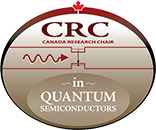- “STUDIES ON GOLD-SEMICONDUCTOR ARCHITECTURES FOR SURFACE PLASMON ASSISTED PHOTOLUMINESCENCE“, MSc in Electrical Engineering, 2006, Université de Sherbrooke, Sherbrooke, Canada. [pdf]
-
Surface plasmons polaritons on metal-semiconductor architecture can play a significant role in nanobiodetection. Those surface plasmons properties are particularly ideal for surface sensing. The general idea of the project is the conception of a biodetector, which probing mechanism is the resonance of surface plasmon polaritons (SPs) with light emitted by the semiconductor substrate via photoluminescence (PL). The measured signal is surface plasmon assisted PL, modulated by presence of biomolecules in the vicinity of the gold film. In addition, surface chemistry of the gold-thiol interface is utilized prior to biofunctionalization, allowing a selective design for the ultra-sensitive detection of different biomolecules. The presented architectures promise strong selectivity, through surface functionalization and enhanced sensivity, from SPs based measurements. The devices fabrication processes are kept simple to offer the benefits of integrated microstructures: miniaturisation, mass fabrication, easy operation and self-alignment between the source and the sensing element. The proposed architectures have open active regions in order to allow a continuous probing and, in addition to be self-referential systems, offer the potential for parallelism, allowing high-throughput screening.Experiments implied the fabrication of subwavelength gold gratings, within an architecture built on a GaAs/AlGaAs heterostructure substrate. Efficient architectures for the integrated infrared SP-PL coupling were designed, built, characterised and their properties analysed to achieve an extensive understanding of the physical processes implied in these integrated biosensors.The research hereby presented is based on very innovative biosensing techniques, on which only very a small amount of literature exists. The experimental and theoretical works presented have therefore been very exploratory and the initial results even went against preliminary expectations. Nonetheless, theoretical details have been developed afterwards to describe the origin of the obtained results and allowed to establish, in a convincing manner, the procedure to follow for an optimal architecture. Critical parameters where identified and their inter-relations established through experimental results and a second round of theoretical analysis. Subsequently, final measurements showed a strong correlation with the latest theoretical model.

